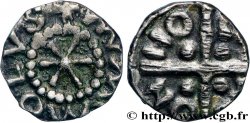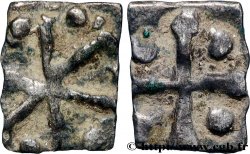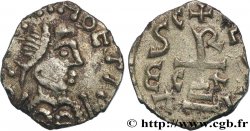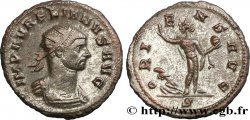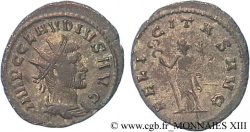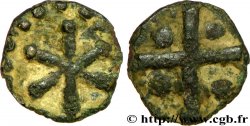v41_1639 - CHALON - SUR - SAÔNE (CABILONNUM) Denier à la croix
MONNAIES 41 (2009)
Startpreis : 380.00 €
Schätzung : 600.00 €
Erzielter Preis : 380.00 €
Startpreis : 380.00 €
Schätzung : 600.00 €
Erzielter Preis : 380.00 €
Type : Denier à la croix
Datum: (VIIIe siècle)
Name der Münzstätte / Stadt : 71 - Chalon-sur-Saône
Metall : Silber
Durchmesser : 12 mm
Gewicht : 0,99 g.
Seltenheitsgrad : R2
Kommentare zum Erhaltungszustand:
Monnaie sur un flan un peu court, mais avec les types complets et même une bonne partie du grènetis du droit. Patine sombre et crouteuse dans les champs alors que les motifs sont sombre et brillants
N° im Nachschlagewerk :
Vorderseite
Titulatur der Vorderseite ANÉPIGRAPHE.
Beschreibung Vorderseite Croix à six branches dans un grènetis.
Rückseite
Titulatur der Rückseite ANÉPIGRAPHE.
Beschreibung Rückseite Croix cantonnée d’un globule dans chaque canton.
Kommentare
Cette monnaie de cuivre ou de billon illustre l’ultime dégénérescence du monnayage de Chalon, avec la conservation des types de droit et de revers, mais sur un flan vil et sans légende. Cette monnaie correspond au n° 149 de l’étude de Ponton d’Amécourt. Ce type pourtant bien particulier n’est même pas repris dans le Belfort.
Il est intéressant de noter qu’une monnaie de ce type, mais d’un poids inférieur, a été retenue par M. Dhénin et P. Schiesser (RN 2007, n° 10 page 287) comme obole.
Tous les deniers de Chalon dérivent du bronze TEVDEBERTE / CA-BI-LON-NV (cf. Ponton d'Amécourt, pl. VI, n° 132) attribué à Théodebert Ier. La croix à six branches est considérée par certains comme étant un chrisme. Les deniers épigraphes de Chalon sont classés selon le nom inscrit au droit ; BADOINVS, MVMMOLVS, MAROL, BIL...INVS, ABBO, NERTVNVS, INPORTVNVS ou BOBO. Mis à part cette inscription du droit, l'évolution de l'épigraphie CABILONNO, au revers, permet de proposer une datation relative. La chronologie proposée par Ponton d'Amécourt est la suivante ; CA BI LON NV, CA BIL ON NO, CA BL ON NO, puis enfin CA BLO NN O+.
This copper or billon coin illustrates the ultimate degeneration of the Chalon coinage, with the preservation of the obverse and reverse types, but on a vile and legendless flan. This coin corresponds to No. 149 of the Ponton d'Amécourt study. This very particular type, however, is not even included in the Belfort. It is interesting to note that a coin of this type, but of a lower weight, was retained by M. Dhénin and P. Schiesser (RN 2007, No. 10 page 287) as an obol. All the deniers of Chalon derive from the bronze TEVDEBERTE / CA-BI-LON-NV (cf. Ponton d'Amécourt, pl. VI, No. 132) attributed to Théodebert I. The six-branched cross is considered by some to be a chrism. The epigraphic deniers of Chalon are classified according to the name inscribed on the obverse; BADOINVS, MVMMOLVS, MAROL, BIL...INVS, ABBO, NERTVNVS, INPORTVNVS or BOBO. Apart from this inscription on the right, the evolution of the epigraphy CABILONNO, on the reverse, allows us to propose a relative dating. The chronology proposed by Ponton d'Amécourt is as follows: CA BI LON NV, CA BIL ON NO, CA BL ON NO, then finally CA BLO NN O+
Il est intéressant de noter qu’une monnaie de ce type, mais d’un poids inférieur, a été retenue par M. Dhénin et P. Schiesser (RN 2007, n° 10 page 287) comme obole.
Tous les deniers de Chalon dérivent du bronze TEVDEBERTE / CA-BI-LON-NV (cf. Ponton d'Amécourt, pl. VI, n° 132) attribué à Théodebert Ier. La croix à six branches est considérée par certains comme étant un chrisme. Les deniers épigraphes de Chalon sont classés selon le nom inscrit au droit ; BADOINVS, MVMMOLVS, MAROL, BIL...INVS, ABBO, NERTVNVS, INPORTVNVS ou BOBO. Mis à part cette inscription du droit, l'évolution de l'épigraphie CABILONNO, au revers, permet de proposer une datation relative. La chronologie proposée par Ponton d'Amécourt est la suivante ; CA BI LON NV, CA BIL ON NO, CA BL ON NO, puis enfin CA BLO NN O+.
This copper or billon coin illustrates the ultimate degeneration of the Chalon coinage, with the preservation of the obverse and reverse types, but on a vile and legendless flan. This coin corresponds to No. 149 of the Ponton d'Amécourt study. This very particular type, however, is not even included in the Belfort. It is interesting to note that a coin of this type, but of a lower weight, was retained by M. Dhénin and P. Schiesser (RN 2007, No. 10 page 287) as an obol. All the deniers of Chalon derive from the bronze TEVDEBERTE / CA-BI-LON-NV (cf. Ponton d'Amécourt, pl. VI, No. 132) attributed to Théodebert I. The six-branched cross is considered by some to be a chrism. The epigraphic deniers of Chalon are classified according to the name inscribed on the obverse; BADOINVS, MVMMOLVS, MAROL, BIL...INVS, ABBO, NERTVNVS, INPORTVNVS or BOBO. Apart from this inscription on the right, the evolution of the epigraphy CABILONNO, on the reverse, allows us to propose a relative dating. The chronology proposed by Ponton d'Amécourt is as follows: CA BI LON NV, CA BIL ON NO, CA BL ON NO, then finally CA BLO NN O+








 Berichten über einen Fehler
Berichten über einen Fehler Die Seite drucken
Die Seite drucken Teilen meiner Auswahl
Teilen meiner Auswahl Stellen Sie eine Frage
Stellen Sie eine Frage Einlieferung/Verkauf
Einlieferung/Verkauf
 Details
Details